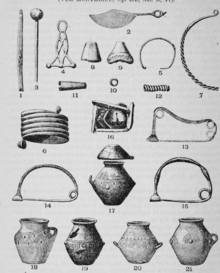Proto-Villanovan culture
 | |
| Geographical range | Europe |
|---|---|
| Period | Bronze Age |
| Dates | circa 1,200 B.C.E. — circa 901 B.C.E. |
| Preceded by | Urnfield culture |
| Followed by | Villanovan culture, Latial culture, Este culture |
The Proto-Villanovan culture was a late bronze age culture that appeared in Italy in the first half of the 12th century BC and lasted until the 10th century BC.
It was part of the central European Urnfield culture system, similarity had been noted in particular with the regional groups of Bavaria-Upper Austria [1] and of the middle-Danube,[1][2] however a derivation from the previous Terramare culture of the Po plain is also hypothesized.[3][4] Various authors, like Marija Gimbutas, associated this culture with the arrival, or the spread, of the proto-Italics into the Italian peninsula.[1]
Proto-Villanovan sites are present all over the peninsula, mostly in the northern-central part but also, to a lesser degree, in Southern Italy and eastern Sicily. Among the most important can be named those of: Frattesina (Veneto), Bismantova and Ripa Calbana (Emilia-Romagna), Cetona and Saturnia (Toscana), Tolfa mountains (Lazio), Pianello di Genga (Marche), Ortucchio (Abruzzo), Timmari (Basilicata), Canosa (Puglia), Tropea (Calabria) and Milazzo (Sicily).
Settlements, usually of small dimensions, were generally built on hills and circundated with fortifications. The economy was mostly based on agro-pastoral activities, metallurgy and trades.
The proto-Villanovans practiced cremation: the ashes were placed in biconic urns, often decorated with geometric designs, and then buried on the ground.
After a period of considerable uniformity from north to south, the Proto-Villanovan culture show a process of regionalization. Starting from c. 950 BC, new regional cultures such as the Este culture, Latial culture, and the Villanovan culture appeared. Although these new cultures share many similarities with the preceding Proto-Villanovan culture, especially funerary customs, they also show innovations.
References
- 1 2 3 M.Gimbutas - Bronze Age Cultures in Central and Eastern Europe p.339-345
- ↑ John M. Coles - The Bronze Age in Europe: An Introduction to the Prehistory of Europe C. 2000–700 BC, p.422
- ↑ Andrea Cardarelli - The collapse of the Terramare culture and growth of new economic and social system during the late Bronze Age in Italy
- ↑ F. di Gennaro - Protovillanoviano , Enciclopedia dell'arte antica (1996)